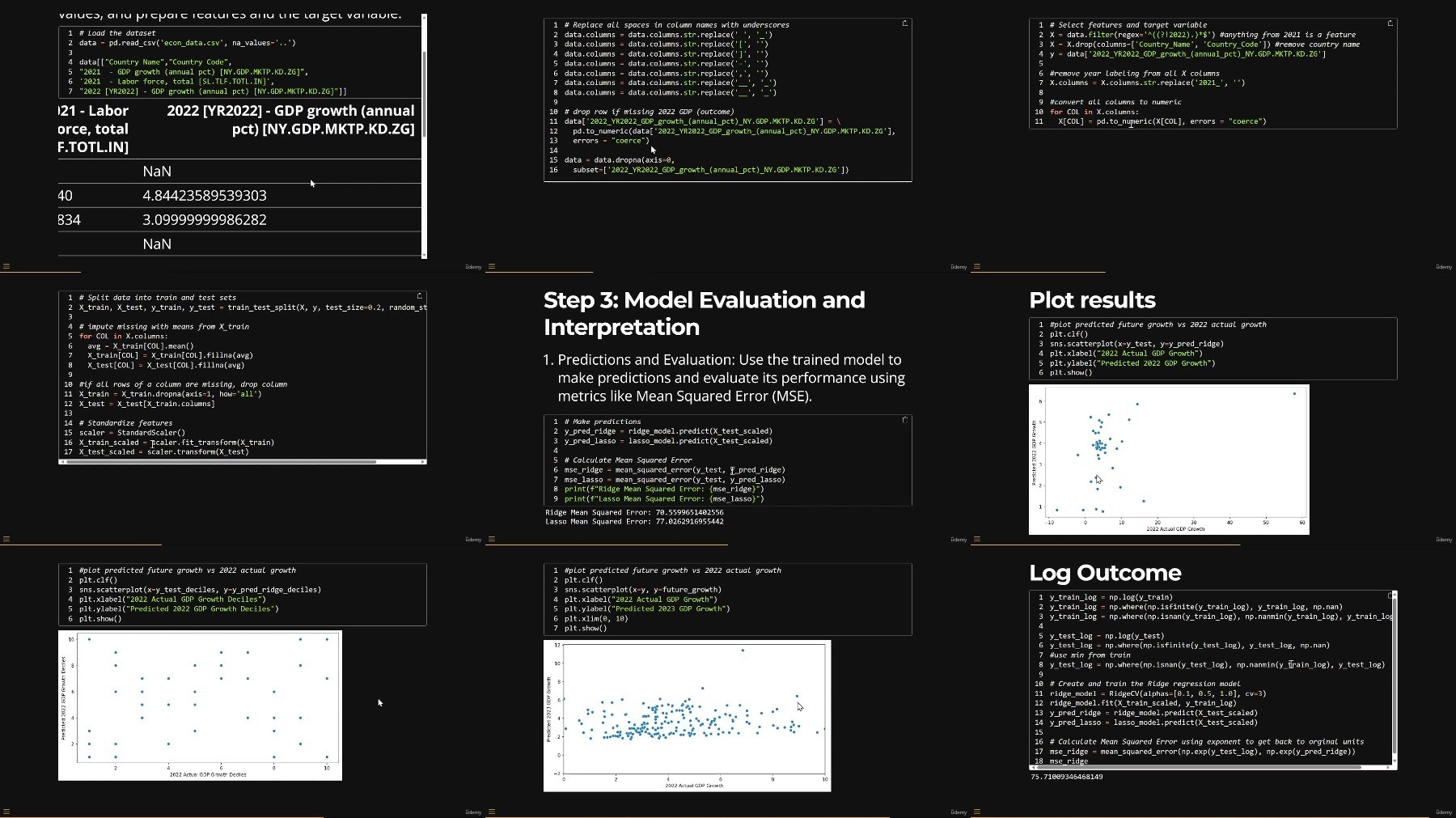
Unlocking Insights: Machine Learning In Econometrics
Published 3/2024
MP4 | Video: h264, 1920x1080 | Audio: AAC, 44.1 KHz
Language: English
| Duration: 3h 24m
This course provides a high-level overview of the most important concepts in machine learning and econometrics.
What you'll learn
Understand Econometric Foundations: Grasp core concepts, models, and techniques in econometrics for data-driven economic analysis.
Apply Statistical Methods: Apply regression analysis, time series modeling, and hypothesis testing to real-world economic datasets.
Integrate Machine Learning: Explore the fusion of ML techniques with econometrics for enhanced predictive modeling and policy insights.
Handle Economic Data: Learn data preprocessing, normalization, and handling outliers in economic datasets.
Predict Economic Trends: Build predictive models to forecast economic trends, aiding informed decision-making.
Ethical Data Usage: Understand ethical considerations and responsible use of data in economic analyses.
Future Trends Awareness: Stay updated on emerging trends, like AI-driven economics, shaping the future of the field.
Requirements
The only prerequisites are curiosity and enthusiasm: A genuine interest in exploring the intersection of machine learning and econometrics for advancing economic insights.
If you are able to run simple commands in python, it will be useful to understand the code examples in the course.
Description
One of the most valuable skills for the future will be unlocking insights from data. Often, practitioners are experts in machine learning or econometrics, but not both. However, having at least a basic understanding of the concepts in both econometrics and machine learning will allow practitioners to unlock data insights to the fullest extent. This course is designed to be a first step in bridging the gap between the two fields. Those fluent in machine learning will benefit from examples of econometric thinking, and econometricians will benefit from discussions of machine learning concepts. In this course, I will discuss the key concepts at the intersection of machine learning and econometrics. I will start by comparing and contrasting the two fields, then I will move into basic data handling skills, then I will discuss keys to exploratory data analysis, and end with a segment on using regression in a machine learning context to make economic predictions. I will give Python code examples for some concepts, and work through a basic case study predicting the economic growth of different countries around the world. This is an introductory course that provides overviews and summaries of the most important ideas, in future courses I will dig deeper into individual concepts - feel free to message me with suggestions!
Overview
Section 1: Introduction to Machine Learning in Econometrics
Lecture 1 Section 1 Overview
Lecture 2 Evolution of Machine Learning and its Role in Econometrics
Lecture 3 Applications of Machine Learning in Economics and Finance
Lecture 4 The Synergy of Traditional and Modern Approaches
Lecture 5 Key Concepts: Supervised, Unsupervised, and Reinforcement Learning
Lecture 6 Challenges and Opportunities in Integrating ML with Econometrics
Lecture 7 Introduction to Relevant Machine Learning Algorithms
Lecture 8 Ethical Considerations in Data-Driven Economic Analysis
Lecture 9 Balancing Model Complexity and Interpretability
Lecture 10 Evaluating Model Performance in Econometric Context
Lecture 11 Future Trends in Machine Learning for Economic Insights
Section 2: Data Preprocessing and Cleaning for ML in Econometrics
Lecture 12 Section 2 Overview
Lecture 13 Types of Economic and Financial Data
Lecture 14 Data Collection and Preprocessing Techniques
Lecture 15 Handling Missing Data and Imputation Methods
Lecture 16 Normalization and Standardization of Economic Variables
Lecture 17 Feature Engineering for Enhanced Econometric Analysis
Lecture 18 Feature Engineering for Enhanced Econometric Analysis - part 2
Lecture 19 Time-Series Data Handling and Temporal Patterns
Lecture 20 Incorporating External Data for Improved Predictions
Lecture 21 Addressing Outliers and Data Anomalies
Lecture 22 Data Quality Assurance in Economic ML Models
Lecture 23 Building a Clean and Structured Economic Dataset
Section 3: Exploratory Data Analysis for Economic Insights
Lecture 24 Section 3 Overview
Lecture 25 Descriptive Statistics and Data Distributions in Economics
Lecture 26 Visualizing Economic Time-Series Data
Lecture 27 Identifying Correlations and Relationships in Economic Variables
Lecture 28 Cluster Analysis for Segmentation of Economic Data
Lecture 29 Detecting Seasonal Patterns and Cycles
Lecture 30 Interactive Data Visualization for Economic Interpretation
Lecture 31 Mapping Economic Trends Using Geographic Data
Lecture 32 Time-Series Decomposition and Components Analysis
Lecture 33 Outlier Detection in Economic Time-Series
Lecture 34 Extracting Insights from Exploratory Analysis in Economics
Lecture 35 Extracting Insights from Exploratory Analysis in Economics - Part 2
Section 4: Regression Analysis and Prediction in Economics
Lecture 36 Regression Models for Economic Analysis
Lecture 37 Regression Models for Economic Analysis - part 2
Lecture 38 Linear Regression and its Assumptions
Lecture 39 Linear Regression in Python
Lecture 40 Ridge and Lasso Regression in Economic Context
Lecture 41 Ridge and Lasso Implementation Strategies
Lecture 42 Ridge and Lasso in Python
Lecture 43 Evaluation Metrics for Economic Regression Models
Lecture 44 Model Interpretation and Feature Importance
Lecture 45 Model Interpretation and Feature Importance - Part 2
Lecture 46 Combining Econometric and Machine Learning Approaches
Lecture 47 Combining Econometric and Machine Learning Approaches - Part 2
Lecture 48 Combining Econometric and Machine Learning Approaches - Part 3
Lecture 49 Combining Econometric and Machine Learning Approaches in Python
Lecture 50 Prediction and Forecasting Using Regression Models
Lecture 51 Prediction and Forecasting Using Regression Models - Part 2
Lecture 52 Regularization Techniques in Economic ML Models
Lecture 53 Regularization Techniques in Economic ML Models - Part 2
Lecture 54 Case Study: Building a Regression Model for Economic Forecasting
Economics Students: Ideal for undergraduate and graduate economics students aiming to enhance analytical skills and apply machine learning in economic research.,Data Analysts: Suited for data analysts seeking to specialize in economic analysis, combining econometrics and machine learning techniques.,Economists: Valuable for practicing economists aiming to modernize their skills, leverage data-driven approaches, and make informed policy recommendations.,Research Professionals: Beneficial for researchers and professionals in economics, finance, and related fields who want to integrate advanced data analysis techniques.,Policy Makers: Useful for policymakers interested in data-driven insights to design effective economic policies and understand their potential impact.,Academic Researchers: Appropriate for researchers and academics exploring interdisciplinary studies at the intersection of economics and machine learning.,Data Science Enthusiasts: Suitable for individuals with a strong interest in data science and its applications in economic analysis.,Prerequisite-Knowledge Seekers: Designed for learners looking to bridge their econometrics and machine learning expertise.

Free search engine download: Unlocking Insights Machine Learning in Econometrics
